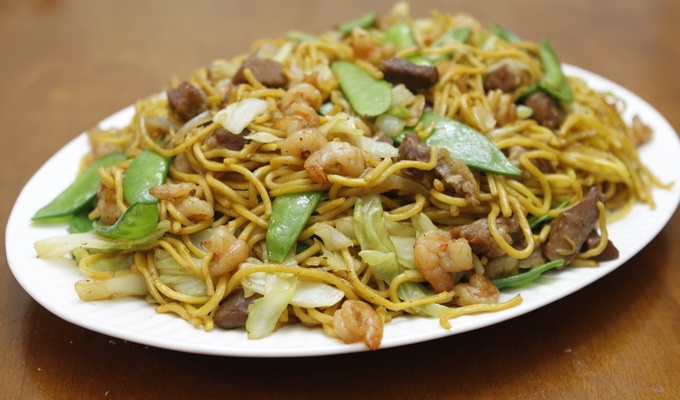Pancit, or pansít, is a broad family of Filipino noodle dishes.
Notable pancit dishes include:
- Batchoy – a noodle soup made with pork offal, crushed pork cracklings, chicken stock, beef loin and round noodles. Its origins can be traced to the district of La Paz, Iloilo City in the Philippines
- Maki mi – thick pork tenderloin soup originating from the Chinese-Filipino community of Binondo, Manila.
- Pancit Abra – common in Northern Luzon, particularly in the province of Abra. A variant of Pancit Miki, in either soupy or fried version.
- Pancit alanganin – originated from Bocaue, Bulacan. It is made similarly to pancit canton but has a soupy broth with added milk.7
- Pancit Bam-I – made with a mix of wheat noodle and rice noodle, also known as Pancit Bisaya. A specialty originating in Cebu, with bihon (rice) and canton (wheat) noodles sautéed together.
- Pancit batchoy – Iloilo's stir-fried version of batchoy.
- Pancit Bato – made with toasted noodles; a local variation near Bato in Camarines Sur
- Pancit bíjon – using rice vermicelli
- Pancit Cabagan – Stir-fried and served either dry with separate soup, or "wet" or soup and noodles combined.
- Pancit canton Ilonggo
- Pancit canton – using egg noodles
- Pancit chami – from Lucena City, Quezon
- Pancit choca – or Pancit pusít, a black pancit from Cavite made with squid ink and bihon.
- Pancit habhab – A Lucban, Quezon specialty. Served in banana leaves, eaten directly without utensils, the name is an onomatopoeia of eating it, like a pig snorts.
- Pancit kilawin – a variety of pancit which originated in Rosario, Cavite. In lieu of rice or wheat noodles, shredded unripe papaya fruit is used cooked with vinegar and fish. Usually partnered with dinuguan, a dish made of pig's blood.
- Pancit kinalas – Naga City, Camarines Sur's version of pancit, in soup or dried form. It consists of noodles garnished by scraped meat from pork or beef's head and other parts, enhanced with a thick deep-brown sauce coming from the brains of a cow or pig. The dish is further flavored with spices (sili and pepper) and served in hot broth. Boiled egg added is optional.
- Pancit lanu – Found only along San Vicente Street in San Pedro, Laguna
- Pancit lomi – Originally from Batangas, pancit lomi is usually sold in eateries across the province. With the mobility of the Filipinos; however, other people got wind of pancit lomi and now different lomihán (eateries serving lomi), panciterias, and carinderias (eateries serving a wider variety of viands with rice) offer it.
- Pancit Lucban – a type found in Lucban. The noodles are mixed in with generous toppings and ingredients.
- Pancit luglúg or Luglóg – a Kapampangan version of pancit palabok that is essentially the same dishes. The only difference is that it uses thicker constarch noodles. The name comes from its traditional method of cooking, which uses a bamboo skimmer to submerge the noodles briefly in boiling water.
- Pancit Malabon – Thick rice noodles with different toppings that originated in Malabon. Early versions of this dish uses bamboo shoots.1
- Pancit mami – round egg noodle soup
- Pancit mayaman – found in Guinayangan, Quezon
- Pancit miki – round egg noodles, or flat yellow noodles, or dusty white noodles either stir-fried or in soupy version.
- Pancit moròng
- Pancit míki-bíhon guisado – round egg noodles with bihon, a hybrid type of stir-fried noodle.
- Pancit Olongapo – pncit miki prepared with sarsa (sauce) made of thickened chicken and pork broth, darkened with a little soy sauce.
- Pancit palabok – uses thinner cornstarch noodles (sometimes substituted with bihon). It is topped with a shrimp-based sauce dyed bright orange with annatto seeds, shrimp, crushed or ground chicharrón, tinapa (smoked fish) flakes, hard-boiled eggs, and green onions.
- Pancit pula – a variation of pancit miki from Batangas City
- Pancit sotanghon – a cellophane noodle soup with a chicken broth base. It may include some kind of meat and vegetable. A typical sotanghon is made with calamansi, sliced straw mushrooms, slivered dark-meat chicken and green onion.
- Pansit langlang – a historical noodle dish from Cavite which is said to be the favorite of Jose Rizal, to the point he mentioned the dish in his novel El Filibusterismo.
- Pansit sabaw – Pansit miki with soup
- Pansit sinanta – also from Tuguegarao, consists of flat egg noodles, bihon, clams and chicken, with broth colored with annatto and served with pinakufu, a variant of dango.
- Pansit Tuguegarao or Batil Patong – not commonly known outside of Tuguegarao in the province of Cagayan in Northern Luzon, Philippines. It is an unusual noodle dish with a sauce based on soy and "cara-beef" beef broth. It is served with two piquant side dishes: a cup of egg-drop soup made with the same cara-beef broth; and a dish of chopped onions, vinegar, or calamansi, chili peppers and soy sauce. The noodles are usually wheat-based and are topped with ground cara-beef, pork liver, mung bean sprouts, and poached egg from whence the name batil patong, literally "scrambled and placed on top" is thought to be derived. Sometimes, other vegetables, crushed pork-rind cracklings or chorizo are also added on top. The soup was served separately.
